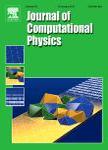版权所有:内蒙古大学图书馆 技术提供:维普资讯• 智图
内蒙古自治区呼和浩特市赛罕区大学西街235号 邮编: 010021

作者机构:Columbia Univ Dept Appl Phys & Appl Math New York NY 10027 USA Chinese Acad Sci Inst Software Beijing 100190 Peoples R China Univ Colorado Dept Comp Sci Boulder CO 80309 USA King Abdullah Univ Sci & Technol Thuwal 23955 Saudi Arabia Chinese Acad Sci State Key Lab Comp Sci Beijing 100190 Peoples R China
出 版 物:《JOURNAL OF COMPUTATIONAL PHYSICS》 (计算物理学杂志)
年 卷 期:2015年第285卷
页 面:55-70页
核心收录:
学科分类:07[理学] 0812[工学-计算机科学与技术(可授工学、理学学位)] 0702[理学-物理学]
基 金:U.S. Department of Energy [DE-FC02-06ER25784] Division of Computing and Communication Foundations Direct For Computer & Info Scie & Enginr Funding Source: National Science Foundation
主 题:Cahn-Hilliard-Cook Thermal fluctuation Implicit method Newton-Krylov-Schwarz Parallel scalability Steady state solutions
摘 要:We present a numerical algorithm for simulating the spinodal decomposition described by the three dimensional Cahn-Hilliard-Cook (CHC) equation, which is a fourth-order stochastic partial differential equation with a noise term. The equation is discretized in space and time based on a fully implicit, cell-centered finite difference scheme, with an adaptive time-stepping strategy designed to accelerate the progress to equilibrium. At each time step, a parallel Newton-Krylov-Schwarz algorithm is used to solve the nonlinear system. We discuss various numerical and computational challenges associated with the method. The numerical scheme is validated by a comparison with an explicit scheme of high accuracy (and unreasonably high cost). We present steady state solutions of the CHC equation in two and three dimensions. The effect of the thermal fluctuation on the spinodal decomposition process is studied. We show that the existence of the thermal fluctuation accelerates the spinodal decomposition process and that the final steady morphology is sensitive to the stochastic noise. We also show the evolution of the energies and statistical moments. In terms of the parallel performance, it is found that the implicit domain decomposition approach scales well on supercomputers with a large number of processors. (C) 2015 Elsevier Inc. All rights reserved.